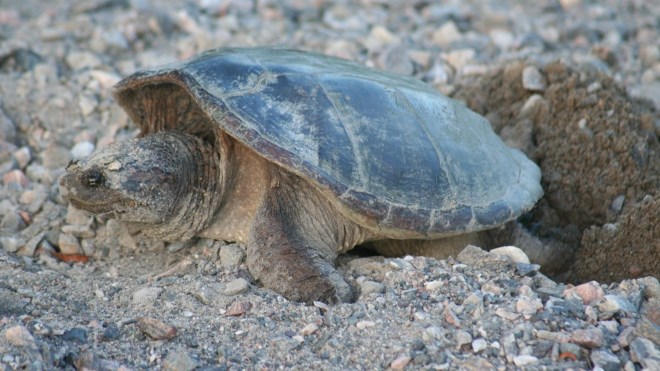There are copious amounts of sand along both sides of the bridge. It was dumped over the rock fill years ago to level off and fill out the gaps that formed when the new cement culvert was put in place.
A small weir on the far side helps to keep the lake level up during the warmer months in the summer; particularly when rain becomes a rare commodity. Sand is always a great medium for looking for signs of activity.
On one side of the bank, there is something. For lack of better description, a long trailing squiggly track is made out at several locations on the ground. Closer inspection shows there are small entrenched marks to the left and right of a trailing squiggle.
Something has come out of the water — it's a great channel for swimmers. The sand is dry, so it must have been early morning or perhaps last night. I will have to return tomorrow and see if the visitor returns as well.
The next morning all secrets are out. The visitor is on the sand, but at a strange angle. The head and upper body seem partially above ground and the rear of the body is slightly below ground in a small pit.
I approach slowly and indirectly so as not to alarm the visitor. Things seem all right as the creature seems to ignore my slow movements. A view from the back shows that the large clawed hind limbs have dug the hole.
Lunging out away from the body first left, and then right small mounds of sand are bordering the hole. The sun has just rose and low angle light glistens off the pupil of the eye embedded in a brown dull-coloured head and a wrinkled, trunk-like neck. The mouth, more like a beak, does not look too friendly. Its back is also dull brown and the tail has primordial lumps on the top, resembling dragon scales of legend.
Snapping turtles are long-lived creatures and must come onto land in order to lay their eggs. This process may take several days as it seems they sometimes come out to test the terrain before the actual egg release occurs.
Using their hind limbs, they extend them sometimes as far as they can reach and push the sand or gravelly soil out of the way to make a pit. The pit itself is usually damp with moisture.
More than 20 eggs are laid within the hole and then covered up again so that the nest is concealed from predators. Raccoons are notorious for finding some of these nests.
Because the turtle must come on land to lay eggs, it becomes most vulnerable. This time of year, snapping turtles will cross roads to get to their destinations. Unwary drivers may tragically hit them and cause serious consequences.
Snapping turtles are a fascinating species to observe. Some examples have shown that they can live as long as the average human.
Chris Blomme is an executive member of the Sudbury Ornithological Society and works with animals at Laurentian University. Have a question for Chris? Send it to [email protected].
Join Sudbury.com+
- Messages
- Post a Listing
- Your Listings
- Your Profile
- Your Subscriptions
- Your Likes
- Your Business
- Support Local News
- Payment History
Sudbury.com+ members
Already a +member?
Not a +member?
Sign up for a Sudbury.com+ account for instant access to upcoming contests, local offers, auctions and so much more.
